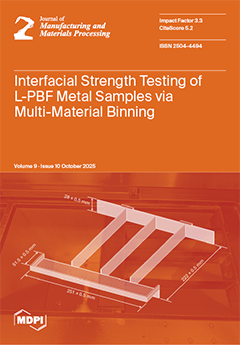Due to its unique benefits over conventional subtractive manufacturing, additive manufacturing methods continue to attract interest in both academia and industry. One such method is called Cold Spray Additive Manufacturing (CSAM), a solid-state coating deposition technology to manufacture repair metallic components using a
[...] Read more.
Due to its unique benefits over conventional subtractive manufacturing, additive manufacturing methods continue to attract interest in both academia and industry. One such method is called Cold Spray Additive Manufacturing (CSAM), a solid-state coating deposition technology to manufacture repair metallic components using a gas jet and powder particles. CSAM offers low heat input, stable phases, suitability for heat-sensitive substrates, and high deposition rates. However, persistent challenges include porosity control, geometric accuracy near edges and concavities, anisotropy, and cost sensitivities linked to gas selection and nozzle wear. Interdisciplinary research across manufacturing science, materials characterisation, robotics, control, artificial intelligence (AI), and machine learning (ML) is deployed to overcome these issues. ML supports quality prediction, inverse parameter design, in situ monitoring, and surrogate models that couple process physics with data. To demonstrate the impact of AI and ML on CSAM, this study presents a systematic literature review to identify, evaluate, and analyse published studies in this domain. The most relevant studies in the literature are analysed using keyword co-occurrence and clustering. Four themes were identified: design for CSAM, material analytics, real-time monitoring and defect analytics, and deposition and AI-enabled optimisation. Based on this synthesis, core challenges are identified as small and varied datasets, transfer and identifiability limits, and fragmented sensing. Main opportunities are outlined as physics-based surrogates, active learning, uncertainty-aware inversion, and cloud-edge control for reliable and adaptable ML use in CSAM. By systematically mapping the current landscape, this work provides a critical roadmap for researchers to target the most significant challenges and opportunities in applying AI/ML to industrialise CSAM.
Full article





